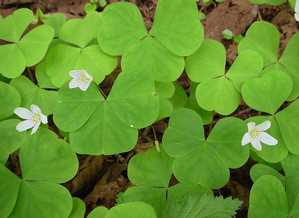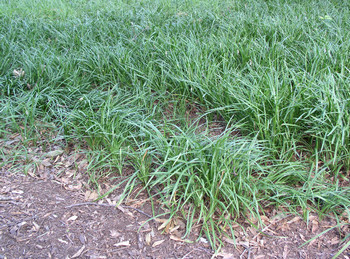Ground covers are an excellent alternative to grass.
 Not only to the add texture, but also color and depth to what would be a dull landscape otherwise.
Not only to the add texture, but also color and depth to what would be a dull landscape otherwise.
Ground covers are excellent in areas where growing grass would pose a challenge.
Common Places To Use Ground Covers
These areas can include but are not limited to:
|
Examples of Colorful Ground Covers
 Some flowering colorful ground covers are:
Some flowering colorful ground covers are:
- Oxalis (pictured)
- Cape Plumbago
- Creeping Phylox
- Evergreen daylily
- Lantana
- Peruvian Verbena
- Shrimp Plant
- Strawberries
- Wedelia
- Carpet Bugle
- Strawberry Begonia
Examples of Ground Covers with Texture
 For texture opt for these:
For texture opt for these:
- Monkey grass (pictured)
- Sprengeri Fern
- Yarrow
- Varigated Vinca
Also there are colorful varieties by their foliage.
Ground Cover Care
Watering and Fertilization
The great thing about ground covers is that they require occasional watering. If it’s in an area where there’s lots of rainfall, you might not even need to water them at all.
But keep in mind, though, that when they are still young they will require more water than when they are older. Once they have matured some, typically you can simply water them occasionally or better yet, install a drip system.
As for fertilizing…
If it’s a drought resistant, woody kind of shrub, then you probably won’t need to fertilize it much. These types of ground covers are pretty resilient. Ground covers with a greener and softer look to them, typically these are perennials, will require more fertilizing because they have a higher need for nutrients.
Keeping It Orderly – Edging, Pruning, and Mowing
What? Mowing your ground cover? Yup, but we’ll get to that in just a moment. First, let’s talk about how your cover can spread.
Like any plant, shrub, tree, lawn… what have you, there will a little upkeep to your ground cover.
If left unattended for long, your cover can begin to grow into your walkway and other areas of your garden. Simply using pruning sheers or some other hand tool may be all you need to keep it trimmed, but if it begins to get out of hand, there’s a few other things you can try.
Create a Barrier
If your ground cover begins growing out of hand and spreading all over the place, you can try creating a barrier out of wood, brick, or some other object to restrict its growth.
If you find that it grows under your barrier you may need deepen the hole you dug and extend your barrier even deeper, below the root level.
Edging
You can save time pruning the edges if you have a good weed eater. Just be careful not to cut too deep into the cover or you’ll end up hurting the plant by weed eating its root.
Mowing
You typically don’t need to mow ground covers, but that’s not always the case. Some covers, especially ones which spread widely by their roots, can create patches of dense areas. If these patches get too cumbersome, your only option may be to mow it in order to get it in line.
If you must use a mower, try to use it just before the growing season starts. Also, don’t mow it too short, make sure to leave about 4″ of height.
As you can see, if you’re looking to cover up that dirt patch in your yard, you’ve got options.

